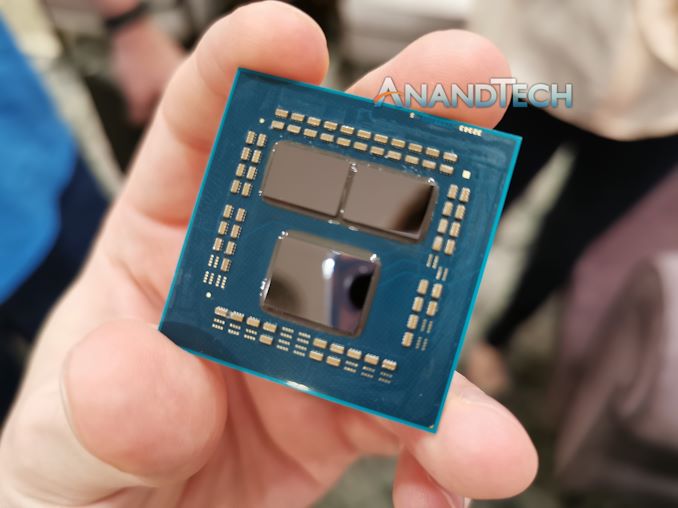Reaching for Turbo: Aligning Perception with AMD’s Frequency Metrics
by Dr. Ian Cutress on September 17, 2019 10:00 AM EST
For those that keep a close eye on consumer hardware, AMD recently has been involved in a minor uproar with some of its most vocal advocates about the newest Ryzen 3000 processors. Some users are reporting turbo frequencies much lower than advertised, and a number of conflicting AMD partner posts have generated a good deal of confusion. AMD has since posted an update identifying an issue and offering a fix, but part of all of this comes down to what turbo means and how AMD processors differ from Intel. We’ve been living on Intel’s definitions of perceived standards for over a decade, so it’s a hard nut to crack if everyone assumes there can be no deviation from what we’re used to. In this article, we’re diving at those perceived norms, to shed some light on how these processors work.
A Bit of Context
Since the launch of Zen 2 and the Ryzen 3000 series, depending on which media outlet you talk to, there has been a peak turbo issue with the new hardware. This turbo frequency issue has been permeating in the ecosystem since Zen 2 was launched, with popular outlets like Gamers Nexus noting that on certain chips, the advertised turbo frequency was only achieved under extreme cooling conditions. For other outlets, being within 50 MHz of the peak turbo frequency has been considered chip-to-chip variation, or a function of early beta firmware. A wide array of people put varying amounts of weight behind this, from conspiracy to not being bothered about it at all.
However, given recent articles by some press, as well as some excellent write-ups by Paul Alcorn over at Tom’s Hardware*, we saw that the assumed public definitions of processor performance actually differs from Intel to AMD. What we used as the default standard definitions, which are based on Intel’s definitions, are not the same under AMD, which is confusing everyone. No one likes a change to the status quo, and even with articles out there offering a great breakdown of what's going on, a lot of the general enthusiast base is still trying to catch up to all of the changes.
This confusion – and the turbo frequency discussion in general – were then brought to the fore of news in the beginning of September 2019. AMD, in a two week span, had several things happen essentially all at once.
- Popular YouTuber der8aur performed a public poll of frequency reporting that had AMD in a very bad light, with some users over 200 MHz down on turbo frequency,
- The company settled for $12.1m in a lawsuit about marketing Bulldozer CPUs,
- Intel made some seriously scathing remarks about AMD performance at a trade show,
- AMD’s Enterprise marketing being comically unaware of how its materials would be interpreted.
Combined with all of the drama that the computing industry can be known for – and the desire for an immediate explanation, even before the full facts were in – made for a historically bad week for AMD. Of course, we’ve reported on some of these issues, such as the lawsuit because they are interesting factoids to share. Others we ignored, such as (4) for a failure to see anything other than an honest mistake given how we know the individuals behind the issues, or the fact that we didn’t report on (3) because it just wasn’t worth drawing attention to it.
What has driven the discussion about peak turbo has come to head because of (1). Der8auer’s public poll, taken from a variety of users with different chips, different motherboards, different cooling solutions, different BIOS versions, still showed a real-world use case of fewer than 6% of 3900X users were able to achieve AMD’s advertised turbo frequency. Any way you slice it, without context, that number sounds bad.
Meanwhile, in between this data coming out and AMD’s eventual response, a couple of contextual discrepancies happened between AMD’s partner employees and experts in the field via forum posts. This greatly exacerbated the issue, particularly among the vocal members of the community. We’ll go into detail on those later.
AMD’s response, on September 10th, was a new version of its firmware, called AGESA 1003-ABBA. This was released along with blog post that detailed that a minor firmware issue was showing 25-50 MHz drop in turbo frequency was now fixed.
Naturally, that doesn’t help users who are down 300 MHz, but it does come down to how much the user understands how AMD’s hardware works. This article is designed to shed some light on the timeline here, as well as how to understand a few nuances of AMD's turbo tech, which are different to what the public has come to understand from Intel’s use of specific terms over the last decade.
*Paul’s articles on this topic are well worth a read:
Ryzen 3000, Not All Cores Are Created Equal
Investigating Intel’s Claims About Ryzen Reliability
Testing the Ryzen 3000 Boost BIOS Fix
This Article
In this article we will cover:
- Intel’s Definition of Turbo
- AMD’s Definition of Turbo
- Why AMD is Binning Differently to Intel, relating to Turbo and OC
- A Timeline of AMD’s Ryzen 3000 Turbo Reporting
- How to Even Detect Turbo Frequencies
- AMD's Fix











144 Comments
View All Comments
MDD1963 - Tuesday, September 17, 2019 - link
AMD's four visits totaling little 1/16th of a second each of a single core at advertised boost clocks within a 45 - 100 secnd period are most impressive! :)realHolt - Tuesday, September 17, 2019 - link
Seen this: https://www.youtube.com/watch?v=3LesYlfhv3otwtech - Tuesday, September 17, 2019 - link
If I buy a processor that's advertised as being able to reach a certain clockspeed, I expect the individual example of that product to be able to reach that speed - not that there are some other units marketed under the same name that may be able to. Better to under-advertise than over-advertise.Korguz - Wednesday, September 18, 2019 - link
twtech and how do you feel about a cpu being advertised as using X amount of power, but using much more then that ?eva02langley - Wednesday, September 18, 2019 - link
It is not ADVERTISED as a 4.4GHz CPU either... you just made the assumption that it was!Techie2 - Tuesday, September 17, 2019 - link
IMNHO it's much nonsense over nothing. No problem with CPU turbo mode IME. Yes there was a 25 MHz drop with the first chipset update to fix overly sensitive load sensing that kept some CPUs at max vcore but other than that no issues for me and no malice or fraud by AMD.FYI - AMD settled the bogus CPU core count lawsuit as it was cheaper to settle a frivolous lawsuit than fight it in U.S. courts where Jackpot Justice prevails by criminals. Pour a cup of coffee on your crotch in a moving vehicle and become an instant millionaire. It's the American way...
zodiacfml - Tuesday, September 17, 2019 - link
Never bothered to read on this issue, surprising Andntech did. I guess its quiet right now in the tech world. This topic is of little value considering that even Intel's turbo boost speeds are not so easy to predict unless you have an application locked to a certain number of threads and CPU utilization.PProchnow - Tuesday, September 17, 2019 - link
Now like if you think Intel I want 5.5Ghz locked in low on 12 cores!!!!I got a 4.4Ghz locked SANDRA Graphics Handling Benchie that convinced me the 3900X R A W K Z !
PProchnow - Tuesday, September 17, 2019 - link
Really, i will KEEP the X470 if this is the best the whole CHANNEL consortium can show me. No huge upside fo buy into.
BTW I have been seeing the Turbo Peaks you got since i dropped the 3900X in the Friday after the Sunday release....AMD direct sale on Sunday Morning. I seem them in CPUZ HWMON max history. That sim-ly grabs the high number for you no B.S.
Peter2k - Wednesday, September 18, 2019 - link
The only important difference might be a better VRM solution, which has been improved generally speaking on x570 compared to older generations.But if you bought the right board then it's not an issue (but then you would have to know what to look for)
And even then, it really only matters once you push past 8 cores and obviously put a high load on the chip
Btw, not needing to buy a new board is a good thing